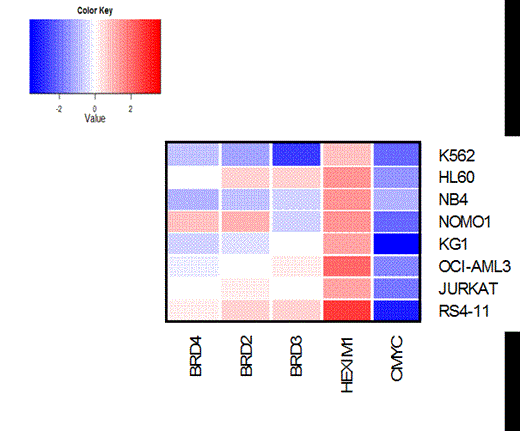Abstract
Background: The bromodomain-containing protein 4 (BRD4) activates the transcription elongation factor b (P-TEFb) which regulates RNA polymerase II. Conversely, hexamethylene bisacetamide (HMBA) inducible protein 1 (HEXIM1) inactivates P-TEFb. BRD4/HEXIM1 interplay influences cell cycle progression and tumorigenesis. It has been widely demonstrated that BRD4 knockdown or inhibition by JQ1 is associated with c-MYC downregulation and antileukemic activity. We recently reported that the small molecule BRD2/3/4 inhibitor OTX015 (Oncoethix, Lausanne, Switzerland), currently in clinical development, mimics the effects of JQ1 (Braun et al, ASH 2013). We evaluated the effect of OTX015 on c-MYC, BRD2/3/4, and HEXIM1 in human in vitro leukemic models.
Methods: c-MYC, BRD2/3/4 and HEXIM1 expression was assessed in six acute myeloid leukemia (AML; K562, HL-60, NB4, NOMO-1, KG1, OCI-AML3) and two acute lymphoid leukemia (ALL; JURKAT and RS4-11) cell lines after exposure to 500 nM OTX015. Quantitative RT-PCR and Western blotting were performed at different time points (24-72h). A heatmap was computed with R-software.
Results: c-MYC RNA levels were ubiquitously downregulated in all AML and ALL cell lines after 24h exposure to OTX015 (Figure 1). c-MYC protein levels decreased to a variable extent at 24-72h in all cell lines evaluated other than KG1. BRD2, BRD3 and BRD4 mRNA expression was significantly decreased in K562 cells (known to be OTX015-resistant) after 48h exposure to OTX015 but was increased in HL60 and NOMO-1 cells, while minimal to no increases were observed in other cell lines. OTX015 induced a decrease in BRD2 protein expression in most cell lines, but not in K562 cells. In contrast, decreased BRD4 protein expression was only seen in the OCI-AML3, NB4 and K562 cell lines. BRD3 protein levels were not modified after OTX015 exposure in all cell lines evaluated other than KG1. HEXIM1 mRNA expression increased after 24h exposure to 500 nM OTX015 in all cell lines except OTX015-resistant K562 cells in which the increase was considered insignificant (less than two-fold). Increases in HEXIM1 protein levels were observed in OCI-AML3, JURKAT and RS4-11 cell lines at 24-72h but not in K562 cells.
Conclusion: Taken together, these results show that BRD inhibition by OTX015 modulates HEXIM1 gene and protein expression, in addition to c-MYC decrease and BRD variations. HEXIM1 upregulation seems to be restricted to OTX015-sensitive cell lines and was not significantly affected in OTX015-resistant K562 cells. Further studies are needed to clarify the role of HEXIM1 in antileukemic activity of BRD inhibitors.
Heatmap of gene expression after exposure to 500 nM OTX015 for 24 or 48h in AML and ALL cell lines. Repression in blue. Overexpression in red.
Heatmap of gene expression after exposure to 500 nM OTX015 for 24 or 48h in AML and ALL cell lines. Repression in blue. Overexpression in red.
Riveiro:OTD: Employment. Herait:OncoEthix: Employment. Dombret:OncoEthix: Research Funding.
Author notes
Asterisk with author names denotes non-ASH members.


This feature is available to Subscribers Only
Sign In or Create an Account Close Modal